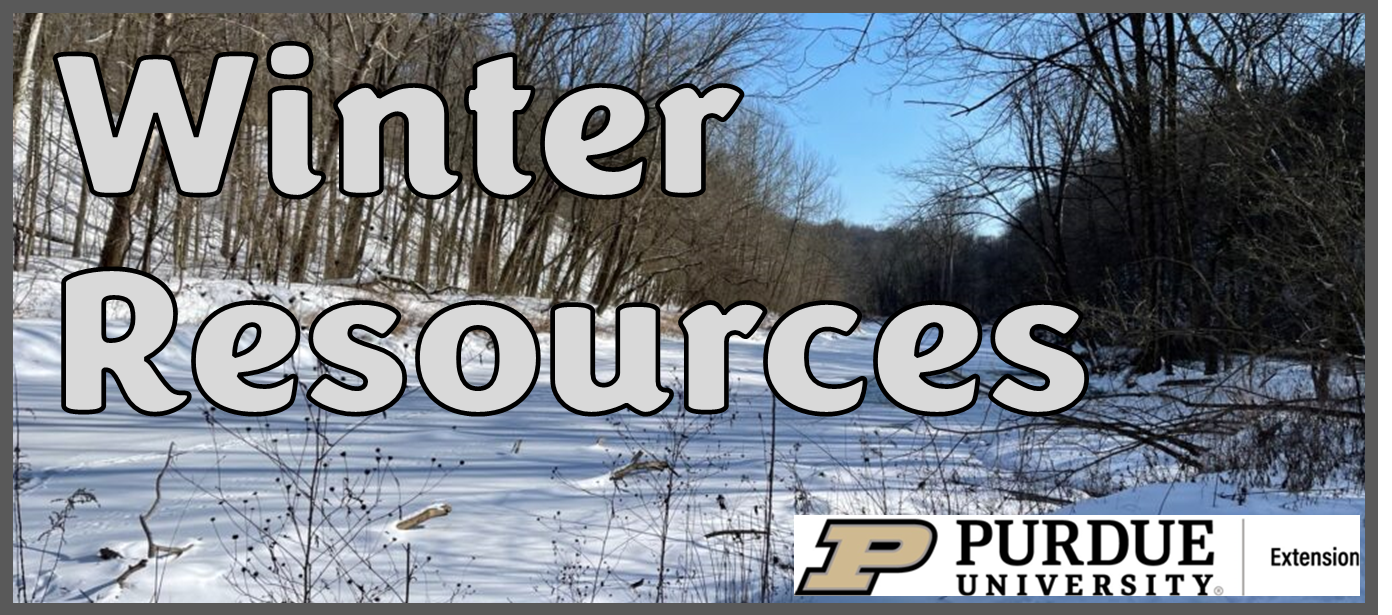CLICK HERE or the image above to access INPREPared's full collection of educational resources about winter weather and extreme cold conditions. The "Winter Resources" site contains a variety of educational materials for use by Extension, teachers, media, and the general public, including PREPnotes, PREPclip videos, archived news postings, ready-to-use social media, and more.
Winter and Extreme Cold Summary Info
This page provides a summary of key terms and important considerations for safety during periods of extreme cold, snow, and/or ice. For more detailed information about a wide variety of winter weather issues, as well as ready to use educational media, please visit our full "Winter Resources" site.
Heavy snowfall and extreme cold can immobilize an entire region. Even areas that normally experience mild winters can be hit with a major snowstorm or extreme cold. Northern-Indiana residents should prepare for increased snowfall (lake affect). Winter storms can result in flooding, storm surge, closed highways, blocked roads, downed power lines and hypothermia.
Key Terms
- FREEZING RAIN: Rain that freezes when it hits the ground, creating a coating of ice on roads, walkways, trees, and power lines.
- SLEET: Rain that turns to ice pellets before reaching the ground. Sleet also causes moisture on roads to freeze and become slippery.
- WINTER STORM WATCH: A winter storm is possible in your area. Tune in to NOAA Weather Radio, commercial radio, or television for more information.
- WINTER STORM WARNING: A winter storm is occurring or will soon occur in your area.
- BLIZZARD WARNING: Sustained winds or frequent gusts to 35 miles per hour or greater and considerable amounts of falling or blowing snow (reducing visibility to less than a quarter mile) are expected to prevail for a period of three hours or longer.
- FROST/FREEZE WARNING: Below freezing temperatures are expected.
Before a Winter Storm
To prepare for a winter storm, you should:
- Have a supply of:
- Rock Salt to melt ice on walkways
- Sand to improve traction
- Snow shovels and other snow removal equipment
- Prepare for possible isolation in your home by having sufficient heating fuel; regular fuel sources may be cut off. For example, store a good supply of dry, seasoned wood for your fireplace or wood-burning stove, and/or maintain a sufficient amount of LP in your tank for at least two-weeks. Winterize your home to extend the life of your fuel supply by insulating walls and attics, caulking and weather-stripping doors and windows, and installing storm windows or covering windows with plastic.
During a Winter Storm
If a winter storm is likely in your area, you should:
- Listen to your radio, television, or NOAA Weather Radio for weather reports and emergency information.
- Eat regularly and drink ample fluids, but avoid caffeine and alcohol.
- Avoid overexertion when shoveling snow. Overexertion can bring on a heart attack—a major cause of death in the winter. If you must shovel snow, stretch before going outside.
- Watch for signs of frostbite. These include loss of feeling and white or pale appearance in extremities such as fingers, toes, ear lobes, and the tip of the nose. If symptoms are detected, get medical help immediately.
- Watch for signs of hypothermia. These include uncontrollable shivering, memory loss, disorientation, incoherence, slurred speech, drowsiness, and apparent exhaustion. If symptoms of hypothermia are detected, get the victim to a warm location, remove wet clothing, warm the center of the body first, and give warm, non-alcoholic beverages if the victim is conscious. Get medical help as soon as
possible. - Conserve fuel, if necessary, by keeping your residence cooler than normal. Temporarily close off heat to some rooms.
- Maintain ventilation when using kerosene heaters to avoid build-up of toxic fumes. Refuel kerosene heaters outside and keep them at least three feet from flammable objects.
- Drive only if it is absolutely necessary. If you must drive, consider the following:
- Travel in the day, don’t travel alone, and keep others informed of your
schedule - Stay on main roads; avoid back road shortcuts
- Maintain a emergency supply kit in your vehicle. Click here for a suggested list of items.
- Travel in the day, don’t travel alone, and keep others informed of your
Guidelines for Traveling
It is not recommended to travel during a winter storm, however, if you become trapped or stranded while traveling consider the following:
- Pull off the highway. Turn on hazard lights and hang a distress flag from the radio antenna or window.
- Remain in your vehicle where rescuers are most likely to find you. Do not set out on foot unless you can see a building close by where you know you can take shelter. Be careful; distances are distorted by blowing snow. A building may seem close, but be too far to walk to in deep snow.
- Run the engine and heater about 10 minutes each hour to keep warm. When the engine is running, open an upwind window slightly for ventilation. This will protect you from possible carbon monoxide poisoning. Periodically clear snow from the exhaust pipe.
- Exercise to maintain body heat, but avoid overexertion. In extreme cold, use road maps, seat covers, and floor mats for insulation. Huddle with passengers and use your coat for a blanket.
- Take turns sleeping. One person should be awake at all times to look for rescue crews.
- Drink fluids to avoid dehydration.
- Be careful not to waste battery power. Balance electrical energy needs—the use of lights, heat, and radio—with supply.
- Turn on the inside light at night so work crews or rescuers can see you.
- If stranded in a remote area, stomp large block letters in an open area spelling out HELP or SOS and line with rocks or tree limbs to attract the attention of rescue personnel who may be surveying the area by airplane.
- Leave the car and proceed on foot— ONLY if necessary—once the blizzard passes.
Following a Winter Storm
The following are guidelines for the period following a winter storm:
- Limit your time outside.
- If you need to go outside, wear layers of warm clothing and keep a close watch for frostbite.
- Avoid carbon monoxide positioning.
- Never heat your home with a gas or stovetop oven.
- If a generator is used to provide power to your home, be sure to maintain the manufacturers recommended distance from the house (only operate in a well ventilated area)
- Reduce your risk of heart attack.
- Overexertion from shoveling show is often a contributor to severe health issues.
- Check on your neighbors, especially elderly or those living alone.
- Keep a watch for signs of hypothermia or frost bite
- Frostbite signs: numbness, white or grayish-yellow skin, firm or waxy skin.
- Frostbite action: go to a warm place, soak in warm water. Do not massage or use a heating pad.
- Hyperthermia signs: shivering, exhaustion, fumbling hands, memory loss, slurred speech and drowsiness
- Hyperthermia action: Go to a warm place and focus on warming the body core first (chest, neck, head and groin). Keep dry, and wrapped with blankets (including head and neck).
Additional Resources
If you need more information contact: inprepared@purdue.edu.
© 2020 Purdue University | An equal access, equal opportunity university | Extension Intranet
615 West State Street, West Lafayette, IN 47907-2053
If you have trouble accessing this page because of a disability, please email us at extension@purdue.edu.



